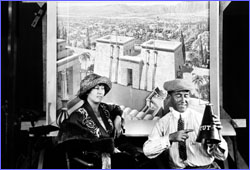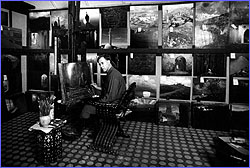
|
 |
 |
Special effects become a moviemaker's staple as films move from documentaries to dramatic stories, and the basic arsenal of trick techniques is established. 1903 Edwin Porter's popular "The Great Train Robbery" features matte shots to composite two separate images, placing a shot of a train into the window of a station. 1906 Edwin Porter directs "The Teddy Bears," one of the earliest stop-motion animation films. A short sequence of frolicking teddy bears, just over a minute in length, takes 56 hours to animate. 1907
1907 Richard Murphy creates a mechanical eagle for "The Eagle's Nest," the forerunner of today's animatronic creatures such as ET and Jaws. The stuffed eagle kidnaps a baby and battles the hero, played by silent director D.W. Griffith. Continue: 1910s Photos: Bison Archives Reel Timeline | 50-Foot Chicken | Wizards of Ahs | Be in Pixels Titanic: What's Real | Virtual Humans | Resources | Teacher's Guide Transcript | Site Map | Special Effects Home Editor's Picks | Previous Sites | Join Us/E-mail | TV/Web Schedule About NOVA | Teachers | Site Map | Shop | Jobs | Search | To print PBS Online | NOVA Online | WGBH © | Updated November 2000 |
 Producers in front of the glass matte painting used
in "Dancer of the Nile"
Producers in front of the glass matte painting used
in "Dancer of the Nile"
 Preparing glass mattes
Preparing glass mattes